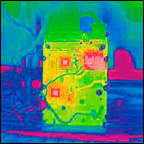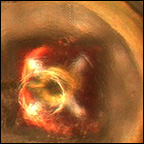Professor Aris Christou
Department of Materials Science and Engineering | Department of Mechanical Engineering
A. James Clark School of Engineering | Universty of Maryland
Research: Biomolecular Sensing
In collaboration with:
- Professor Mohamad Al-Sheikhly (Materials Science and Engineering)
- Professor William E. Bentley (Fischell Department of Bioengineering)
- Professor Christopher C. Davis (Electrical and Computer Engineering)
- Professor Emeritus Joseph Silverman (Materials Science and Engineering)
The requirement for storage at higher densities and rapid sorting of more data is becoming a limiting technology. While contemporary research in such diverse areas as quantum. molecular, and optical computing and data storage offer the promise to extend the capability of contemporary technology, a new generation of technology is needed to satisfy the requirements of the next millennium. The hybrid operation of biologic and electronic components, as is being investigated by various departments at our College of Engineering, offers the technical potential to meet these requirements. Our DNA-based biomolecular sensing and computing program is categorized as follows:
Ultra Scale High-Density Hybrid DNA Memory with Massively Parallel Data Searching Module
It is our goal to build the first DNA memory device in a program that will demonstrate the viability of an Ultra Scale high-density hybrid DNA memory with a near real-time massively parallel data searching capability. In achieving this goal, a number of innovative technology advances are visualized:
- A paradigm shift from enzymatic aqueous reactions to photo-induced surface reactions
- The use of photo-enhanced hybridization of surface attached DNA probes to DNA targets in a gel
- The use of advanced opto-electronics for data searching and retrieval
- The adaptation of this approach into a practical, high-density hybrid memory/rapid database-searching module.
Gene Chip and Polymerase Chain Reaction
In this area, we are working on the molecular biology analytical techniques that incorporate DNA hybridization (e.g. Northern bolts, Southern bolts, gene chip arrays, polymerase chain reaction). Particularly, polymerase chain reaction (PCR) currently involves the cycling of temperatures for the annealing, elongation, and denaturation steps. Photo-induced hybridization offers the potential for eliminating the annealing step at reduced temperature, wherein on would do annealing and elongation at the same temperature. Additionally, one could potentially "tailor" the specificity of various primers hybridized to the DNA based on light excitation. That is, the incident light affords another control variable for fine tuning the PCR reaction. This is an enormous advantage over the current state-of-the-art. Similar advantages are envisioned in Northern ovens, and importantly, gene chip arrayers and readers, etc.
Evanescent Wave Exited Fluorescent Biosensors
Our work on optical biosensors uses evanescent wave, guiding optical structures, such as tapered optical fibers, biconical tapers, or prisms used in total internal reflection, to excite fluorophores electively bound at a surface. One approach that is used to detect bacteria and viruses is to bind a specific DNA fragment on the surface where the evanescent wave is present. A fluorophore-labeled piece of DNA from the biological agent that it is desired to detect will hybridize to the surface and lead to the detection of fluorescence. Specific novel features of our sensor scheme are the use of semiconductor laser excitation, near-infrared dye labels, and single-mode tapered fibers.



